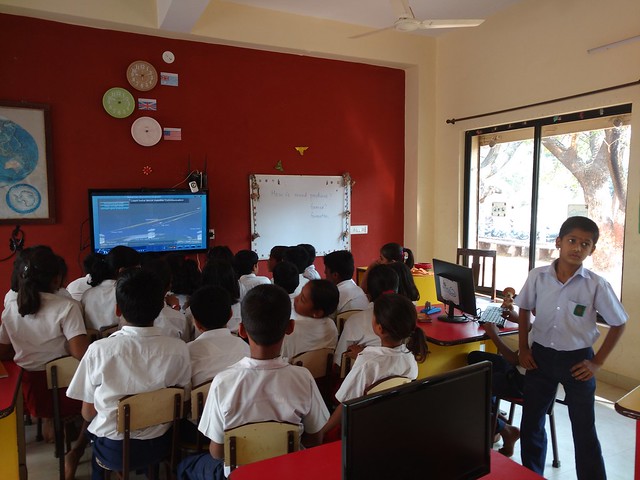'What visual mischief can I indulge in?' Illustrator Kabini Amin on her illustration process
Posted by Yamini Vijayan on March 30, 2018Over the last couple of years, Kabini Amin has illustrated three wonderful books for Pratham Books. In this short e-mail interview, Pratham Books editor Zeba Imtiaz talks to Kabini about her illustration process, approach and inspiration.

Do you think there's a difference between illustrating for adults and children?
Not particularly. Over time I've come to realise that there's a child in each of our adult-sized bodies, and every child is a complete person in themselves. The more kids I meet, the more they blur these differences between 'adult' and 'children' for me. Same holds true for the adults I meet too!
I might tweak my vocabulary a bit here and there, much like when we talk to children, but I think the last thing they need is to be talked down to, and that should reflect in the pictures as well.
Having said that, what I enjoy the most about illustrating for children is the room that the genre allows for being whimsical, silly, playful, as compared to content for 'adults'. Which is sad because we all need more of those qualities in our lives!
A greater difference exists, I think, in illustrating for people of different cultural and soci-economic groups. It is here that one has to take into account visual literacy and language, and that's really what can be challenging, and interesting as an illustrator.
Your style was very varied in Dum Dum-a-Dum Biryani, Kalpana's Cycle, and Creatures of Old. How do you choose a particular style and medium for a story?
I think I mostly let the style choose me! Every time I've tried to be bullish and enter a project with a style in mind, it has ended up being a block. For me, the content and tone of the story are what first inform the style. Of course, as an illustrator, I bring in my perspective through the choices I make; do I supplement or subvert the content? What additional information can I contribute through the visuals? What visual mischief can I indulge in? And it is this kind of questioning that helps me craft a particular style for a story.
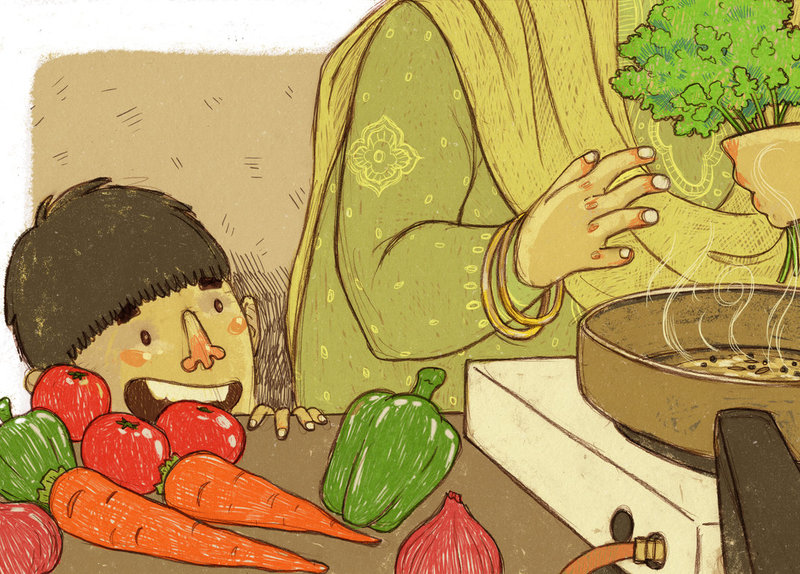
What kind of research and preparation goes into illustrating a book for children? For instance, what research went into illustrating 'Creatures of Old'?
Like I mentioned earlier, I think the preparation does depend on the kind of audience of children being addressed.
While illustrating for 'Creatures of Old', I was quite lucky to be living and working amongst biologists and herpetologists who enthusiastically shared with me books and photographs of fossils and various reptiles. I also spent some time stalking chickens.
So there was some amount of study of reptiles and birds that went into the drawings.
But, more than deep dives into anatomy and such specific research, I had a central question; how can I depict dinosaurs? I was never much of a dino nerd, even though I'm really into biology, and I never really cared for the fanged and hyper muscular depictions of dinosaurs in popular media. I wondered if I could show these animals as goofy beings, bumbling and crashing their way through primordial forests, and paleontology as a wondrous science that solves the puzzles of our biological history.
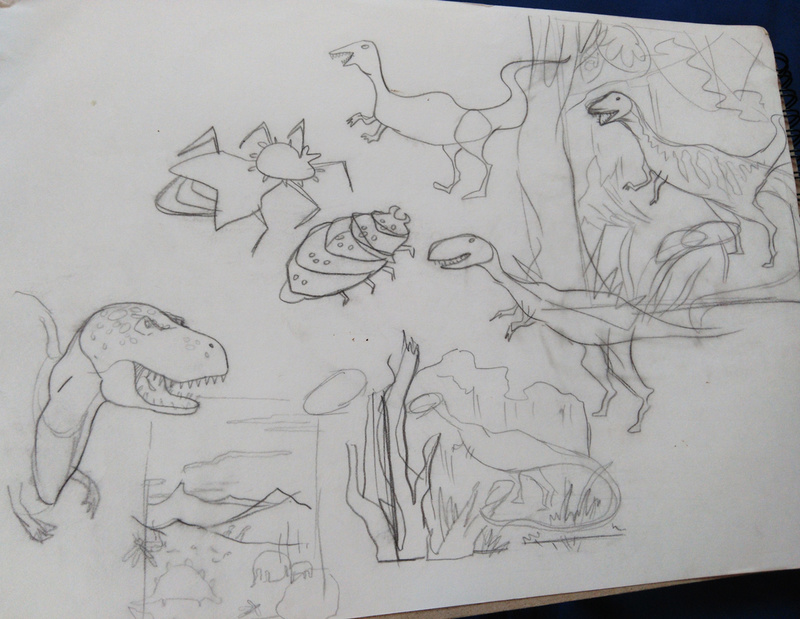
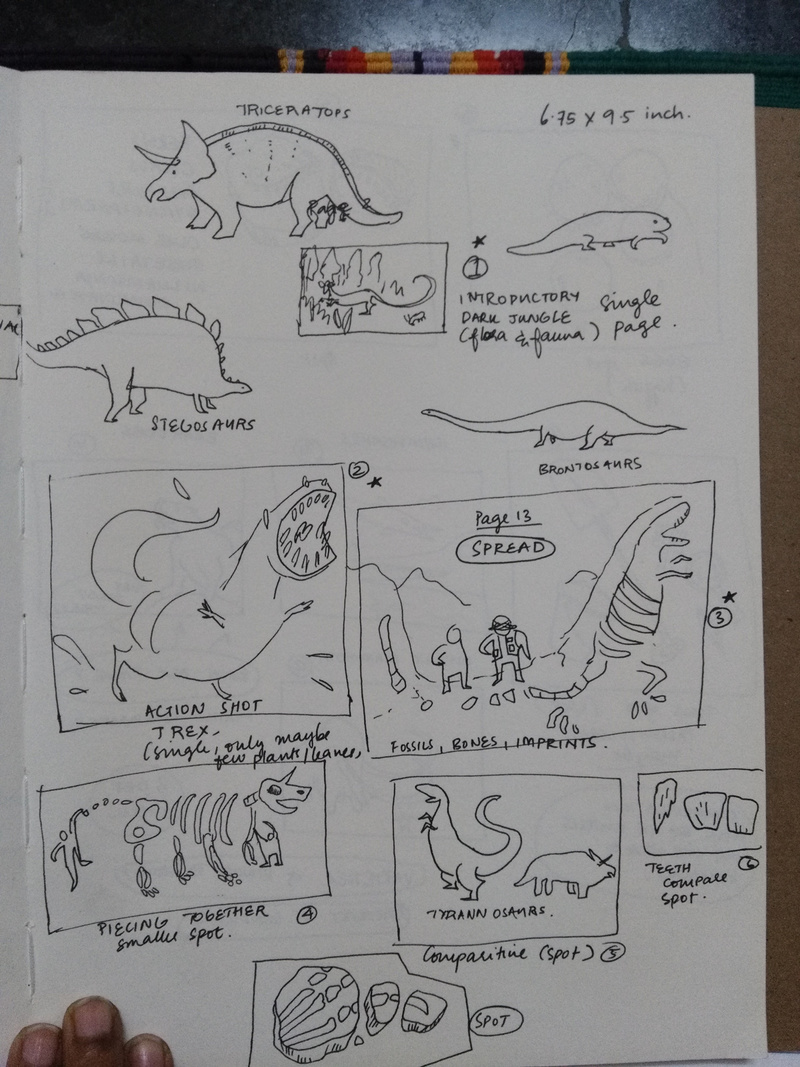
How do you find inspiration for your work?
Inspiration is everywhere, really. More often I'm fighting an overflow of ideas rather than a lack of it.
But if I am feeling dry and dusty, I try to step outside, go for a walk, or play with an animal, buy groceries, meet a friend, listen to music, make soup. Basically try to get out of my head, give myself some room to process whats going on and make creative connections.
What do you most enjoy illustrating?
That's a tricky question. I consider illustration a medium of visual communication, and as such it is the brief and context of the project that often excites me more. I'll look for what it is about the project that is interesting, and that makes whatever I have to depict interesting too!
But if you're asking me what I like to draw, then it's mostly everything. People, faces, characters, plants and their parts, animals, textures, lately I've been drawing a lot of landscapes. Everything. Except cars and airplanes, I find them to be a bore.
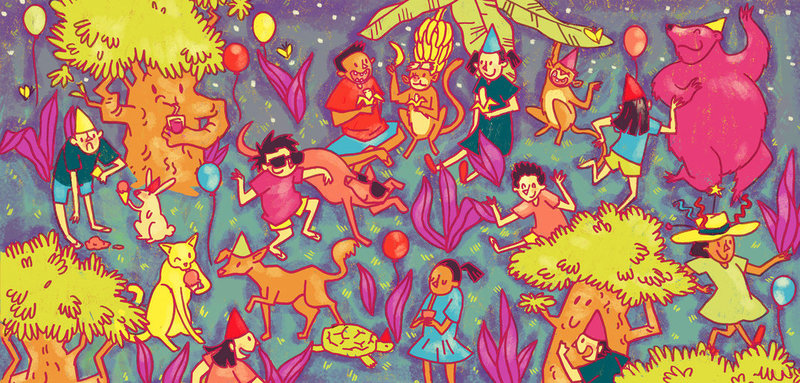
We noticed that you travel a lot. Do your travels influence your art?
Well, travel affects me as a person, and that finds articulation in my art. There are obvious things like the fact that the world, it's landscapes and people are so diverse and magical that travelling to a new place can be like a concentrated shot of sensory inspiration! There are so many new, exciting things to see on this planet! And some of these places and faces end up shaping the places and faces I have to draw. For instance, I was able to clearly visualise the landscapes in Creatures of the Old thanks to the gorgeous and harsh Death Valley desert in California that I had visited a couple of years ago.
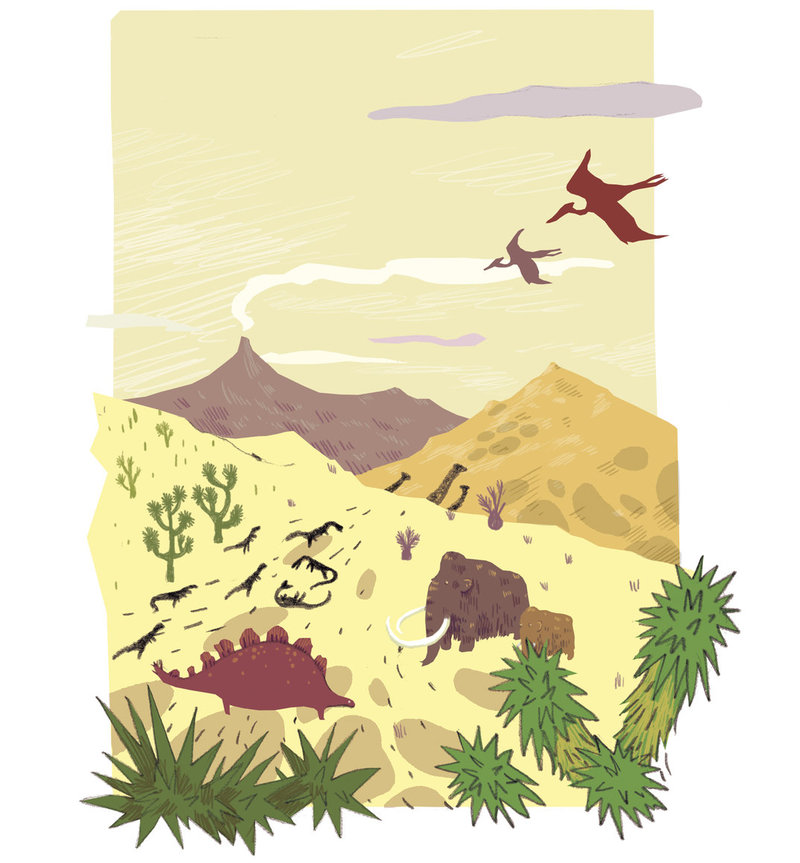
I also like travelling to understand the various ways in which we are connected, the ways in which we are all subject to the same forces of life and nature. Also to acknowledge all the ways in which we are diversely different. What I hope for, is for all this roaming around to add to my meta understanding of how this world works. And this understanding does end up tinting my work with a certain sensibility.
Kabini Amin graduated as an animator from the National Institute of Design, Ahmedabad. Fascinated by the image-making process and stories in general, she is interested in the medium of illustration as an exploration ground. When not drawing, she likes reading non fiction and undertaking gastronomic adventures. You can read her stories Creatures of Old, Kalpana's Cycle, and Dum Dum-a-Dum Biryani for free on StoryWeaver. These are available in English, Hindi, Marathi, Kannada and Tamil.
Be the first to comment.How Story Time Is Making Learning Fun for 30,000 Students in Maharashtra’s Govt Schools
Posted by Remya Padmadas on June 19, 2017In the hilly terrains of Phaltan, Satara district, Maharashtra a movement to seed the joy of reading in classrooms is being quietly seeded in 150 Zilla Parishad schools.
Pragat Shikshan Sanstha is an educational enterprise that supports schools, teachers and children in the district of Phaltan and other nearby areas. The organisation works with students through their own flagship school and after school programmes, and also trains teachers in good educational practices in government schools. By engaging researchers, government officials and the general public in an ongoing dialogue Pragat Shikshan Sanstha hopes to positively impact the education ecosystem.
“We are trying to impact the educational ecosystem by changing the image of ‘the child’ and ‘the teacher’ through excellent classroom practices, sound pedagogies, elements of classroom research and education for equality.” Manjiri Nimbkar, Secretary, Pragat Shikshan Sanstha.
Drop Everything and Read
One of Pragat Shikshan Sanstha’s areas of focus is setting up more libraries in the region. This, they felt was something that would not only benefit the schools in the area but also children from other nearby communities. The organisation felt that it was imperative to make books and read aloud sessions a part of their training offering to teachers. The idea was to get more teachers to use more books in their classrooms and libraries through read alouds and storytelling sessions.
Reading in so important in early childhood as books can free a child, and give them the opportunity to think and imagine. By helping children express themselves in varied ways, books encourage them to understand and empathise with the lives and experiences of those who are marginalised.
Pragat Shikshan Sanstha came across StoryWeaver - a digital repository of multilingual stories for children from Pratham Books and in it, discovered a source of stories in Marathi, the language of the region. All content on StoryWeaver is openly licensed under CC-BY4.0 and can be read, translated, downloaded, printed and shared for free. Through StoryWeaver, the organisation has access to many joyful stories in Marathi but without having to heavily invest in buying books regularly.
It’s story time!
Pragat Shikshan Sanstha curated a list of stories, in different levels across a variety of themes and topics and circulated it amongst the teachers who were being trained in using storytelling as a medium for language development.
These teachers also double up as librarians! The teachers choose from the circulated list the stories they think will work best for their students, downloaded them as per their class’s requirement and conduct read aloud sessions. Each library is equipped with a tablet and a projector which the teachers use to project stories off StoryWeaver. They also conduct various activities - art & craft, book reviews, games, skits etc around the books to help extend learning.
Pratham Books was fortunate to watch one of these wonderful sessions at a Zilla Parishad schools in the region. The classroom was equipped with a projector donated by a local badminton association and some computers (in working condition) from a corporate.
Bohra Bai, who teaches grades 2 and 3 in the school, first did a little warm up with the children before asking them to sit down. The story she had chosen that day was ‘Sam’s Christmas Present’ by Annie Besant and Alicia D’Souza in Marathi. Bohra Bai started from the cover page and urged the children to note everything that was there on the cover and predict what could the book be about. She got them to make connections, relate it to their own lives and pointed out sight words. Basically, everything you would expect a good teacher to do with a good book.
“We have regular sessions with teachers on how good read alouds are done, what are the different activities one can do with the books and the teachers value these training.”
When we took Bohra Bai aside to ask her a few question, young Diksha took over and continued to read the story aloud to her classmates, and did a tremendous job of it!
“Storybooks with illustrations help children imagine and understand better, along with learning about new cultures or things they don't see otherwise. For example with this book Sam's Christmas Present, they got to know about the festival of Christmas or the food that is eaten during Christmas as children from villages have never seen or eaten things like that.” shared Bohra Bai.
When asked about using technology in the classroom, she had this to say: “Projecting stories help catch children's attention better because this is new for them. Its interesting because it looks like TV to them.”
Stories can be an excellent tool in the classroom, an idea Bohra Bai strongly agrees with! “Stories really help children expand their vocabulary. For example, they get to know options of words in proper language that they use otherwise in their day to day lives, in dialects of that language. This really helps language development.”
A total of 150 Government schools in the Phaltan district have libraries & digital set up from PSS. About 30000 children from Grades 2 to 7, get to listen, read and enjoy stories in Marathi and Hindi.
“Going forward we hope to create more books for children with imaginative illustrations and help people understand the importance of illustrations. Create literature to help children understand and tackle issues and problems. Encourage children’s own creative writing.”
Be the first to comment.